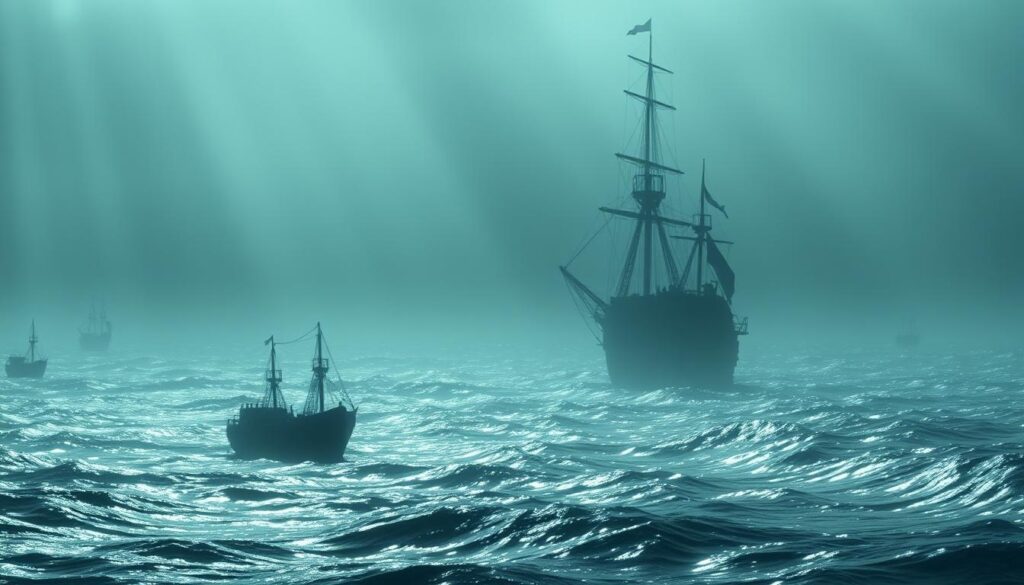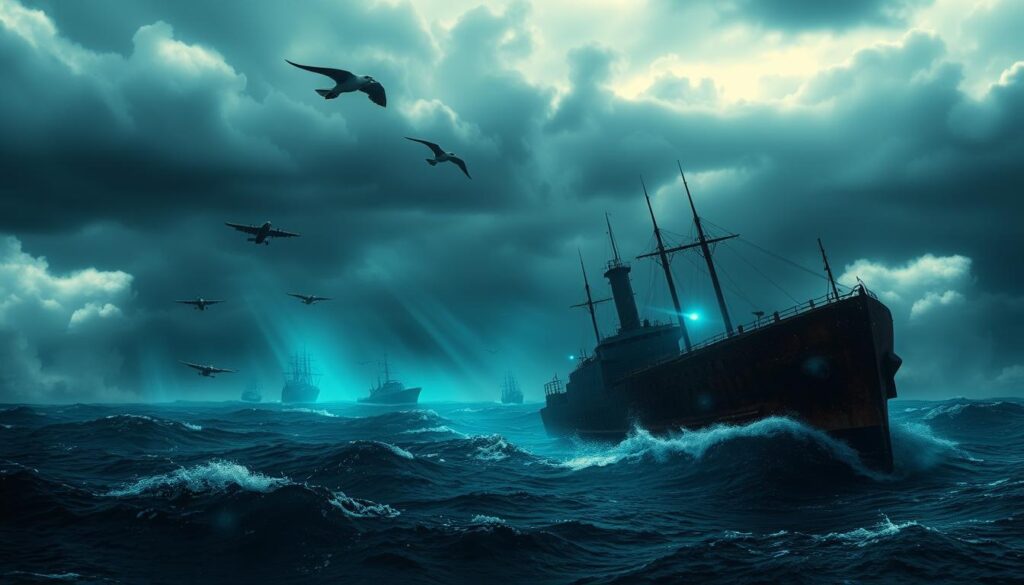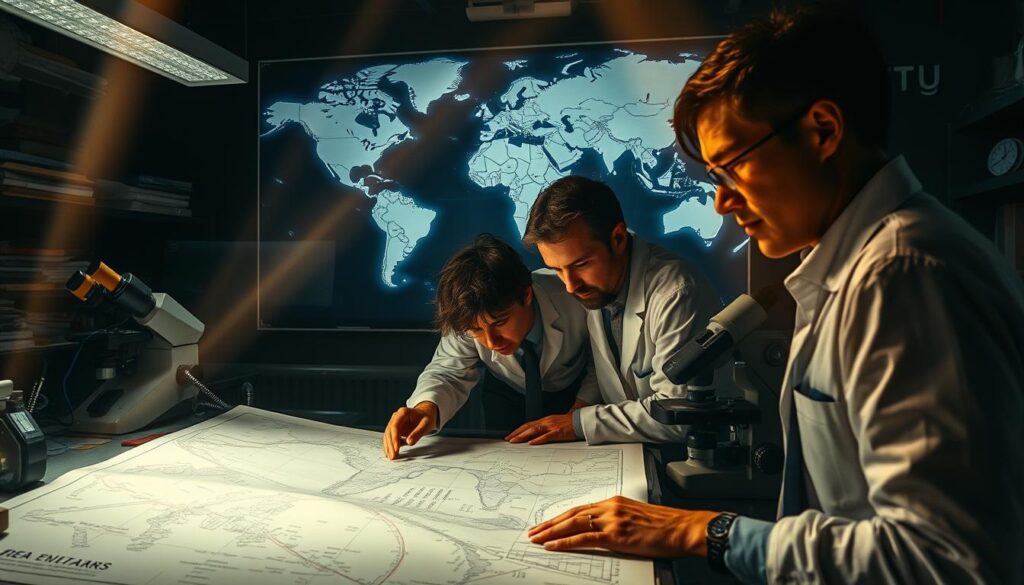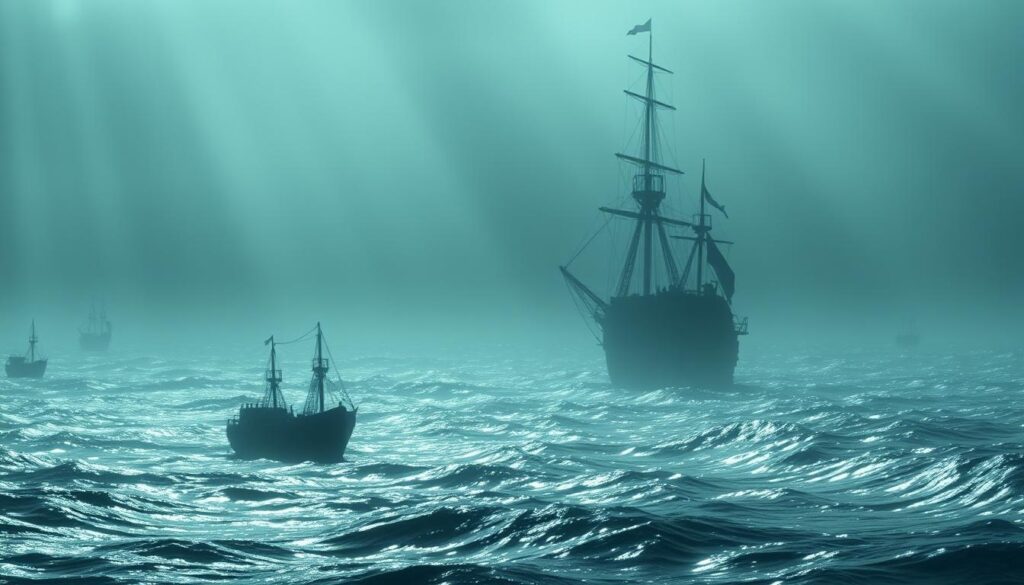Lost Ships – For centuries, the seas have kept secrets of ships that vanished and then reappeared. These stories of ships found empty or resurfacing years later fascinate many. The Mary Celeste and the Arctic’s SS Baychimo are just a few examples. They mix fact and legend, making us curious about what happens to ships lost at sea.

These lost ships challenge our understanding of the ocean’s dangers and mysteries. Some return with clues, while others leave no sign. This article explores the science, history, and fascination behind these enigmatic journeys. It shows how modern technology and old legends help us understand the ocean’s hidden truths.
Key Takeaways Lost Ships
- Many ships that disappeared and reappeared hold clues about ocean currents and human survival.
- Maritime mysteries often mix real events with myths passed through generations.
- Stories of lost at sea vessels highlight gaps in historical records and navigation tech.
- Modern tracking tools now solve some cases, but many remain unsolved puzzles.
- These tales inspire books, movies, and ongoing debates about the sea’s secrets.
The Mysterious Phenomenon of Vanishing Vessels
The ocean is vast and has seen many ships vanish. Stories of missing vessels have been told for centuries. They are like riddles in history.
Historical Context of Maritime Disappearances
In ancient times, sailors spoke of Lost Ships in storms. In the 19th century, whalers disappeared in cold waters. By the 1900s, even steel ships like the USS Cyclops vanished without a clue in 1918.
Since the 1800s, over 1,000 Lost Ships have gone missing. Only 10% of these cases have been solved.
- Ancient era: Greek texts describe “ghost fleets” lost in the Aegean Sea.
- Age of Sail: The 17th-century Marie Celeste (though detailed in Section 3) set a template for modern mystery.
- Modern times: The 2013 disappearance of the Royal Clipper sparked global searches, highlighting ongoing enigmas.
The Psychological Impact of Lost Ships
Families of sailors lived with uncertainty for their loved ones. Coastal towns held rituals to honor the missing. These rituals mixed hope with fear.
Superstitions like the “Flying Dutchman” grew from these stories. They added fear to maritime culture.
“The void left by a missing ship becomes a mirror for humanity’s fear of the unknown.” – Maritime Historian Dr. Elena Marquez
Why These Stories Captivate Our Imagination
Even with modern technology, vanishing Lost Ships fascinate us. They show the sea’s dual nature: provider and predator. Movies like Pirates of the Caribbean and podcasts keep these stories alive.
The mystery of vanishing ships continues because the ocean still has secrets. Each missing vessel challenges science and storytelling.
Next, we’ll explore how one ship’s ghostly return changed maritime history. We start with the legendary Mary Celeste.
The Mary Celeste: The Ghost Ship That Defined a Genre
In 1872, the Mary Celeste was found adrift near the Azores Islands. Its crew was missing, but the ship’s supplies were still there. This made it the most famous ghost ship in history, sparking ongoing debates.
The ship’s sails were still set, and its cargo of alcohol was untouched. Yet, there was no one on board.
When investigators looked at the ship, they found half-eaten meals and navigational charts. They also found the captain’s missing family, but their personal items were still intact. There were no signs of violence or disaster that could explain why the crew left so suddenly.
Theories abound, from panic caused by alcohol fumes to wild ideas like sea monsters or alien abductions. But the truth remains a mystery.
Here’s what we know for sure:
- The crew vanished on December 4, 1872, leaving the Mary Celeste adrift.
- All lifeboats were still attached, suggesting a hasty escape.
- No distress signals were ever sent.
This mystery has shaped how abandoned ships are portrayed in stories. Books, movies, and TV shows often use the Mary Celeste as a model for eerie sea legends. It remains the ultimate ghost ship tale, showing that the ocean still holds secrets we can’t fully explain.
Ships That Disappeared and Reappeared: Famous Historical Cases
Stories of ships that disappeared and reappeared have sparked legends for years. These empty vessels, found drifting without anyone on board, are part of a strange maritime phenomenon. Three tales are especially chilling, showing the mystery of these disappearances, Lost Ships.
SS Baychimo: The Arctic Ghost Ship
In 1931, the SS Baychimo got stuck in ice and was left behind. But, people kept seeing it until 1969, even though it had no crew. This strong ship drifted for years without anyone finding out what happened to it.
Carroll A. Deering: The Ghostly Schooner
Lost Ships – In 1921, the Carroll A. Deering was found on a beach in North Carolina, empty. There were no signs of the crew, and everything was left untouched. Many theories exist, but the truth is still a mystery.
MV Joyita: Pacific Ocean Mystery
In 1955, the MV Joyita was found far from where it was supposed to be. It had no people on board, but there were signs of blood and a burned radio room. Despite many investigations, the reason for its disappearance is still unknown.
These stories show that the sea still holds secrets. Each case adds to the maritime phenomenon of ships that vanished and reappeared. They leave us with more questions than answers, Lost Ships.
The Bermuda Triangle Connection: Fact vs. Fiction

The Bermuda Triangle, located between Miami, Bermuda, and Puerto Rico, is known for maritime mysteries. Many stories of ships and planes disappearing here spark debates. But science has found explanations for these ocean mysteries.
Scientific Explanations for Triangle Disappearances
Experts point to natural reasons for the Triangle’s mystique:
- Gulf Stream currents can cause sudden weather changes
- Methane gas bubbles can upset ships
- Human mistakes in busy shipping areas
Notable Ships Lost and Found in the Triangle
The USS Cyclops went missing in 1918, leaving no trace. Flight 19 disappeared in 1945, adding to the area’s mystery. Yet, no ship has been found here, contradicting tales of time warps or aliens.
Debunked Myths About the Region – Lost Ships
“The Triangle’s disappearance rate matches other busy routes,” says oceanographer Dr. Elena Torres.
A 2023 study showed no more unexplained ship reappearances here than worldwide averages. Insurance costs are normal, proving there’s no supernatural danger. Here’s a comparison:
| Area | Annual Disappearances | Notes |
|---|---|---|
| Bermuda Triangle | ~20 | Matches global shipping density |
| North Atlantic Route | ~22 | Higher traffic volume |
Today’s technology shows most disappearances are due to known risks, not ghosts or aliens.
Ghost Ships in Popular Culture – Lost Ships
Ghost ships have captivated us for centuries, appearing in everything from classic literature to blockbuster films. Samuel Taylor Coleridge’s Rime of the Ancient Mariner and the Flying Dutchman legend are just a few examples. These tales mix truth with the supernatural, creating lasting fascination.
Today, movies like Pirates of the Caribbean and books like Clive Cussler’s Ghost Ship bring these mysteries to life. Documentaries like Ghost Ships of the Great Lakes blend fact and speculation, sparking our curiosity about what lies beneath the waves.
“It is a dim, and distant day—/Calmley will I your story lay.”
So, why do these stories continue to captivate us? They tap into our deep-seated fears of the ocean’s vastness and our own vulnerability. Every ghost ship tale, from the Mary Celeste to fictional ones, reflects our endless curiosity about the unsolved. Modern audiences love these stories because they combine history with the eerie, showing that the sea still holds secrets worth exploring.
- Ghost Ship (2016 film) reimagines the SS Ourang Medoo legend
- Documentaries like Coast to Coast AM dissect real-life nautical mysteries
- Books like The Devil’s Race explore maritime legends with both scholarly and fictional approaches
Whether in books, films, or podcasts, these stories remind us that the ocean’s depths and our imagination are endless, Lost Ships.
Scientific Explanations for Maritime Reappearances
Understanding how ships reappear often starts with nature’s forces. Ocean currents act like highways, moving abandoned vessels across vast distances. The Gulf Stream, for instance, can carry a derelict ship thousands of miles, turningship mysteriesinto solvable puzzles. Scientists use drift patterns to predict where lost ships might resurface, reducing theunexplained ship reappearancesthat once baffled sailors.
Ocean Currents and Drift Patterns – Lost Ships
Major currents like the North Atlantic Gyre create predictable paths. When a vessel stops moving, these currents steer it toward new locations. Researchers use models to map these journeys, helping locate missing ships faster.
Weather Phenomena and Their Effects – Lost Ships
- Microbursts and rogue waves can disable ships, making them vanish temporarily.
- Fog or waterspouts hide vessels from view, creating illusions of disappearance.
- Electrical storms cause maritime phenomenon like St. Elmo’s fire, which sailors once mistook for ghostly signals.
Modern Technology in Tracking Lost Vessels
AIS and GPS systems now track 90% of commercial ships in real time. Satellite images and EPIRB beacons alert rescuers instantly. Yet gaps remain in remote zones, where unexplained ship reappearances still occur due to signal loss or equipment failure. These tools cut mystery but don’t erase it entirely.
Science clarifies manyship mysteries, but the ocean’s scale ensures some tales stay unresolved. Technology bridges gaps, proving even today’s answers spark new curiosity.
Modern Cases of Reappearing Ships
Lost Ships – Modern maritime mysteries still happen, with ships disappearing and then showing up years later. Technology hasn’t solved these puzzles. Three cases are particularly interesting:
- MV Lyubov Orlova (2013): A cruise ship broke free in the Atlantic and was never found. Satellites spotted its rusted hull, but it was never recovered.
- MV Jian Seng (2006): Found in Australian waters, it had cargo but no crew. It was linked to smuggling, but the crew’s fate is still a mystery.
- MV High Aim 6 (2003): Found in the Indian Ocean with engines running. It’s believed pirates were involved, but no one was caught.
Unlike old times, today’s ships that disappeared and reappeared often hide secrets of crime. Pirates, smugglers, and fraudsters use the sea’s vastness to hide. Satellites and drones help find these ships, but the ocean is still full of abandoned ships.
“The challenges remain vast. Even with tech, human factors like crime complicate every investigation.” — Coast Guard Investigator, Maritime Safety Bureau
These stories show the sea still keeps secrets. Each abandoned ship tells a story of danger, mystery, and the thin line between adventure and danger.
Modern maritime mysteries show that, even with new tools, the sea’s power to hide and reveal ships remains.
To solve these mysteries, we need both advanced technology and old-fashioned detective skills. The search goes on, Lost Ships.
Investigating Maritime Mysteries: Methods and Challenges

Solving nautical mysteries needs the latest science and human skills. Forensic oceanographers track lost ships with advanced tools. Legal experts sort out who owns what. Here’s how they solve these mysteries:
Forensic Oceanography Techniques – Lost Ships
- Computer models simulate ocean currents to predict ship drift patterns
- Satellite data and buoy networks map environmental conditions
- Material analysis of ship structures reveals clues like corrosion timelines
The Role of Survivor Testimonies – Lost Ships
Survivors often have gaps in their memory after trauma. Investigators check their stories against physical evidence like:
- Logbook entries
- GPS data
- Weather records
“A single oil stain or radio transcript can validate or debunk a survivor’s story.” – Dr. Elena Voss, maritime investigator
Legal Implications of Reappeared Vessels – Lost Ships
| Case | Legal Issue | Resolution |
|---|---|---|
| Bel Amica (2006) | Salvage rights dispute | Court awarded 90% of recovered cargo to original owners |
| SS Ourang Medoo (2014) | Inheritance claims | Crew descendants settled for $12M after DNA verification |
| MV Doulos (1991) | Insurance fraud investigation | Settled after proving mechanical failure, not sabotage |
Every ship found brings up new questions about human strength and legal rules. Science and law keep evolving to tackle these maritime mysteries.
Lessons from the Deep: What These Stories Teach Us
Stories of lost at sea vessels and maritime disappearances show the ocean’s power. Today, we have better tools and plans to avoid disasters. But, some mysteries still remain.
Ships like the MV Joyita or the Carroll A. Deering show us what we don’t know. They teach us about the risks of humans and nature.
| Past Challenges | Modern Solutions |
|---|---|
| Unreliable communication | Satellite tracking and AIS systems |
| Slow rescue responses | Automated distress signals and global SAR networks |
Abandoned ships also harm the environment. They leak toxins that hurt marine life. Now, we make sure to clean up ships in an eco-friendly way.
“The ocean’s ocean mysteries challenge our sense of control. They remind us that curiosity and caution must coexist.”
These stories push us to keep getting better. They lead to new ideas in ship design and safety. But, some secrets, like the Bermuda Triangle, still puzzle us.
These tales link our search for answers with the sea’s mystery. They teach us to respect the unknown and keep improving safety. This lesson is as important today as it was in 1872, when the Mary Celeste was found alone.
Conclusion: Lost Ships
“The ocean holds stories older than our ships—and some we may never fully unravel,” said historian Dr. Eleanor Marlowe.
| Ship Name | Mystery | Status | Year |
|---|---|---|---|
| Mary Celeste | Crew vanished mid-voyage | Unsolved | 1872 |
| SS Baychimo | Abandoned ship spotted decades after sinking | Confirmed sightings | 1931 |
| MV Joyita | Found adrift with no crew, no clues | Partially explained | 1955 |
Stories of ghost ships like the Mary Celeste and ships that reappeared, like the SS Baychimo, mix truth and legend. Today’s technology, like satellite tracking and sonar, uncovers some secrets. Yet, many mysteries remain. Maritime mysteries show us the ocean’s depths still hide secrets. Each abandoned ship or rediscovered wreck raises more questions.
Science explains some, like how currents moved the Joyita far off course. But others, like the Mary Celeste’s empty decks, remain a mystery. Advances in technology, like drones and AI, bring us closer to the truth. Yet, the mystery of ghost ships and science remains intriguing, Lost Ships.
Will technology solve all mysteries? Maybe not. But that’s what makes them so captivating. The sea’s secrets keep us curious: What lies beneath? What ship will next defy logic? The allure of these enigmas draws us to the edge of what we know and don’t know. The next chapter is waiting, just beyond the horizon.
Further Reading and Resources for Maritime Mystery Enthusiasts
Start with books like *Ghost Ships* by Greg Vaux for a deep dive into maritime legends. It covers famous ghost ships and their mysteries. For the science behind nautical mysteries, check out *Oceanography and the Bermuda Triangle*. These books mix fact and fascination to keep you curious.
Watch documentaries like *The Bermuda Triangle Enigma* (National Geographic) and *Lost Ships Rediscovered* (PBS). They use expert analysis to explore real cases. Netflix also has series like *Mysteries of the Deep*, which tells the stories of reappeared vessels.
Visit museums like the Mariners’ Museum in Virginia or Halifax’s Maritime Museum of the Atlantic. They have exhibits on the *Mary Celeste* and other ghost ships. These museums often have virtual tours, so you can explore from anywhere.
Check out websites like NOAA’s Ocean Currents Tracker for interactive data on drift patterns. The International Maritime Organization’s archives have historical records. Platforms like Zooniverse let you help map shipwrecks or decode logbook entries.
Listen to podcasts like *Sail into History* and *Nautical Mysteries Uncovered*. They offer audio journeys into unsolved cases. You’ll hear from oceanographers and historians, adding depth to the stories of famous ghost ships.
Books, documentaries, and online tools can turn curiosity into discovery. Explore reputable sources to learn more about the science and stories behind maritime legends. The seas still have secrets—keep exploring!
FAQ
What is the historical context of maritime disappearances?
For centuries, people have written about ships disappearing at sea. This has happened from ancient times to today. Some thought it was magic, while others looked for real reasons – Lost Ships.
How have these disappearances affected maritime culture and psychology?
Lost Ships have had a big impact on sailors and their families. They’ve also shaped the sea’s culture. Stories and myths have grown, still exciting us today.
Why do these stories remain so compelling?
These tales of ships disappearing and then showing up again are fascinating. They tap into our fear of the unknown and our love for the sea. Even with new technology, these mysteries still grab our attention.
What is the significance of the Mary Celeste case?
The Mary Celeste is famous for being a “ghost ship.” Found in 1872, it had no crew but was still sailing. This mystery has sparked many theories and stories in books and movies.
What are some other famous historical cases of disappeared and reappeared Lost Ships?
There are many famous cases. The SS Baychimo was lost in 1931 but was seen many times after. The Carroll A. Deering was found empty in 1921. Lost Ships – The MV Joyita vanished in 1955 but was found later with no one on board.
What is the connection between the Bermuda Triangle and maritime disappearances?
The Bermuda Triangle is known for strange sea disappearances. But, experts say it’s due to strong currents, bad weather, and mistakes, not magic.
How have Lost Ships influenced popular culture?
Ghost ships have inspired many stories. Classics like “The Rime of the Ancient Mariner” and the Flying Dutchman legend are famous. Today, they appear in movies and books, captivating audiences.
What scientific factors can explain how ships can disappear and reappear?
Ships can seem to vanish and then show up again due to ocean currents, weather, and technology. Today, finding lost ships is easier thanks to GPS and satellites.
What are some examples of modern cases of reappearing ships?
Modern cases include the MV Lyubov Orlova, which drifted across the Atlantic in 2013. The MV Jian Seng was found abandoned in 2006. The MV High Aim 6 was found in 2003 with no crew. These often involve crime.
How do investigators approach the challenge of solving maritime mysteries?
Investigators use forensic oceanography and talk to survivors. They also deal with legal issues like salvage rights and insurance claims.
What broader lessons can we learn from the stories of disappeared and reappeared ships?
These stories teach us about safety at sea and the power of the ocean. They remind us of our vulnerability, even with technology. They also lead to protecting the environment from abandoned ships.
Source link
- https://www.boatdesign.net/threads/lost-and-found-ship-reappears-90-years-after-going-missing.53392/
- https://www.abandonedspaces.com/wrecks/ship-resurfaces.html
- https://www.youtube.com/watch?v=kE6rUx9yYOo
- https://nypost.com/2024/05/03/missing-ship-discovered-at-the-bottom-of-lake-michigan-over-100-years-later/
- https://www.the-sun.com/news/11252509/cursed-ship-finally-discovered/
